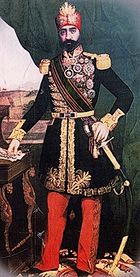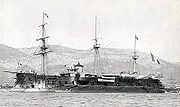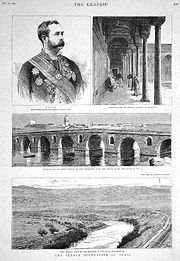
French occupation of Tunisia
Encyclopedia
The French conquest of Tunisia occurred in two phases in 1881: the first (28 April–12 May) consisting of the invasion and securing of the country before the signing of a treaty of protection, and the second (10 June–28 October) consisting in the suppression of a rebellion. The French protectorate of Tunisia
that was established lasted until the independence of Tunisia on 20 March 1956.
 Tunisia
Tunisia
had been a province of the Ottoman Empire
since the Conquest of Tunis (1574), although with great autonomy under the authority of a Bey
. In 1770, Admiral De Broves for Louis XV bombarded the cities of Bizerte
, Porto Farina and Monastir
in retaliation for acts of piracy. In the 19th century Tunisian commercial contacts with Europe
were numerous, and there was a population of French, Italian and British expatriates in the country, represented by Consulates. France had also made a major loan to Tunisia in the mid-19th century. The Tunisian government was weak, with an inefficient tax system that only brought it one-fifth of the tax collected. The economy was crippled with a series of droughts and the elimination of corsair
s by Western fleets. Lastly, Tunisians had little control on foreign trade as ancient 16th century agreements with European powers limited custom taxes to 3%. As a result, its small industry was devastated by imports, especially in the area of textiles.
of 1870–71, France's international prestige was severely damaged, and both Italy
and the United Kingdom
attempted to reinforce their influence in Tunisia. The Italian representative failed through clumsiness, but the British representative Richard Wood
was more successful. In order to limit French influence, Wood obtained the reinstatement of Tunisia as a province of the Ottoman Empire
in 1871, although autonomy was guaranteed at the same time. Great Britain continued to try to exert influence through commercial ventures; these were not successful, however. There were also various Tunisian land ownership disputes between France, Britain and Italy.
The French naturally wished to take control of Tunisia, neighbour of the French colony of Algeria
, and to suppress Italian and British influence there. At the Congress of Berlin
in 1878 following a three-year crisis in the Balkans
, a diplomatic arrangement was made for France to take over Tunisia while Great Britain obtained control of Cyprus
from the Ottomans. Finally, the use of Tunisian territory as a sanctuary by rebel Khroumir bands gave a pretext for the military intervention.
 On 28 April 1881, 28,000 men under General Forgemol de Bostquénard
On 28 April 1881, 28,000 men under General Forgemol de Bostquénard
entered Tunisia. On 1 May, the city of Bizerte
surrendered to the 8,000 men of Jules Aimé Bréart, who then continued to Tunis
.
Bréart entered Tunis between May 3 and May 6, 1881. He had in his possessions the Bardo Treaty establishing a protectorate on Tunisia
, cabled to him on the eve by the French government. On May 11, General Bréart, the general consul Théodore Roustan and the General Pierre Léon Mauraud, accompanied by an armed escort, presented to the bey of Tunis, residing in Ksar Saïd, the clauses of the Bardo Treaty. Surprised, Sadok Bey requested several hours for reflection, and immediately gathered his cabinet. Some of its members insisted that the bey should escape towards Kairouan
to organize the resistance, but Sadok Bey finally decided to accept the protectorate. The Bardo Treaty was signed by both parties, under the threat of the French troops on 12 May 1881.
An insurrection soon broke out in the south on 10 June 1881, and then in Sfax
. Six ironclads were dispatched from Toulon
(Colbert, Friedland, Marengo, Trident, Revanche, Surveillante) to join the French Navy ships in Tunisian waters. In Sfax, three ironclads from the Division of the Levant were already present (Alma
, Reine Blanche
, La Galissonnière), together with four cannon boats. Sfax was bombarded, and on 16 July the city was invested after hard fighting, with 7 dead and 32 wounded for the French. At Kairouan
32,000 men, 6,000 horses and 20,000 tons of supplies and material were landed. Kairouan was taken without a fight on 28 October 1881.
 Great Britain and Germany
Great Britain and Germany
silently approved the invasion of the country, while Italy protested in vain.
Tunisia thus became a French protectorate, with great powers for the French, the French Resident being simultaneously Prime Minister
, controller of the State's finances, and Commander in Chief of its armed forces. In 1882, Paul Cambon
energetically took advantage of his position as Resident, leaving the Bey essentially powerless, and in effect administering Tunisia as another French colony. Later, the French established an important naval base at Bizerte in 1898.
Italy would respond with the 1911–12 Italo-Turkish War
leading to the Italian occupation of Libya
.
French Protectorate of Tunisia
The French protectorate of Tunisia was established in 1881, during the Scramble for Africa, and lasted until Tunisian independence in 1956....
that was established lasted until the independence of Tunisia on 20 March 1956.
Early contacts

Tunisia
Tunisia , officially the Tunisian RepublicThe long name of Tunisia in other languages used in the country is: , is the northernmost country in Africa. It is a Maghreb country and is bordered by Algeria to the west, Libya to the southeast, and the Mediterranean Sea to the north and east. Its area...
had been a province of the Ottoman Empire
Ottoman Empire
The Ottoman EmpireIt was usually referred to as the "Ottoman Empire", the "Turkish Empire", the "Ottoman Caliphate" or more commonly "Turkey" by its contemporaries...
since the Conquest of Tunis (1574), although with great autonomy under the authority of a Bey
Bey
Bey is a title for chieftain, traditionally applied to the leaders of small tribal groups. Accoding to some sources, the word "Bey" is of Turkish language In historical accounts, many Turkish, other Turkic and Persian leaders are titled Bey, Beg, Bek, Bay, Baig or Beigh. They are all the same word...
. In 1770, Admiral De Broves for Louis XV bombarded the cities of Bizerte
Bizerte
Bizerte or Benzert , is the capital city of Bizerte Governorate in Tunisia and the northernmost city in Africa. It has a population of 230,879 .-History:...
, Porto Farina and Monastir
Monastir, Tunisia
-Areas within Monastir:Monastir's north-eastern territories lead into a place called Route de la Falaise, through which you will reach its most notable suburb, Skanes, which is 6 miles from Monastir's town centre...
in retaliation for acts of piracy. In the 19th century Tunisian commercial contacts with Europe
Europe
Europe is, by convention, one of the world's seven continents. Comprising the westernmost peninsula of Eurasia, Europe is generally 'divided' from Asia to its east by the watershed divides of the Ural and Caucasus Mountains, the Ural River, the Caspian and Black Seas, and the waterways connecting...
were numerous, and there was a population of French, Italian and British expatriates in the country, represented by Consulates. France had also made a major loan to Tunisia in the mid-19th century. The Tunisian government was weak, with an inefficient tax system that only brought it one-fifth of the tax collected. The economy was crippled with a series of droughts and the elimination of corsair
Corsair
Corsairs were privateers, authorized to conduct raids on shipping of a nation at war with France, on behalf of the French Crown. Seized vessels and cargo were sold at auction, with the corsair captain entitled to a portion of the proceeds...
s by Western fleets. Lastly, Tunisians had little control on foreign trade as ancient 16th century agreements with European powers limited custom taxes to 3%. As a result, its small industry was devastated by imports, especially in the area of textiles.
Colonial competition
Following the Franco-Prussian WarFranco-Prussian War
The Franco-Prussian War or Franco-German War, often referred to in France as the 1870 War was a conflict between the Second French Empire and the Kingdom of Prussia. Prussia was aided by the North German Confederation, of which it was a member, and the South German states of Baden, Württemberg and...
of 1870–71, France's international prestige was severely damaged, and both Italy
Kingdom of Italy (1861–1946)
The Kingdom of Italy was a state forged in 1861 by the unification of Italy under the influence of the Kingdom of Sardinia, which was its legal predecessor state...
and the United Kingdom
United Kingdom of Great Britain and Ireland
The United Kingdom of Great Britain and Ireland was the formal name of the United Kingdom during the period when what is now the Republic of Ireland formed a part of it....
attempted to reinforce their influence in Tunisia. The Italian representative failed through clumsiness, but the British representative Richard Wood
Richard Wood
Richard Marlon Wood is a former American football All-American linebacker who played in the National Football League.-College career:...
was more successful. In order to limit French influence, Wood obtained the reinstatement of Tunisia as a province of the Ottoman Empire
Ottoman Empire
The Ottoman EmpireIt was usually referred to as the "Ottoman Empire", the "Turkish Empire", the "Ottoman Caliphate" or more commonly "Turkey" by its contemporaries...
in 1871, although autonomy was guaranteed at the same time. Great Britain continued to try to exert influence through commercial ventures; these were not successful, however. There were also various Tunisian land ownership disputes between France, Britain and Italy.
The French naturally wished to take control of Tunisia, neighbour of the French colony of Algeria
Algeria
Algeria , officially the People's Democratic Republic of Algeria , also formally referred to as the Democratic and Popular Republic of Algeria, is a country in the Maghreb region of Northwest Africa with Algiers as its capital.In terms of land area, it is the largest country in Africa and the Arab...
, and to suppress Italian and British influence there. At the Congress of Berlin
Congress of Berlin
The Congress of Berlin was a meeting of the European Great Powers' and the Ottoman Empire's leading statesmen in Berlin in 1878. In the wake of the Russo-Turkish War of 1877–78, the meeting's aim was to reorganize the countries of the Balkans...
in 1878 following a three-year crisis in the Balkans
Balkans
The Balkans is a geopolitical and cultural region of southeastern Europe...
, a diplomatic arrangement was made for France to take over Tunisia while Great Britain obtained control of Cyprus
Cyprus
Cyprus , officially the Republic of Cyprus , is a Eurasian island country, member of the European Union, in the Eastern Mediterranean, east of Greece, south of Turkey, west of Syria and north of Egypt. It is the third largest island in the Mediterranean Sea.The earliest known human activity on the...
from the Ottomans. Finally, the use of Tunisian territory as a sanctuary by rebel Khroumir bands gave a pretext for the military intervention.
Occupation

Léonard-Léopold Forgemol de Bostquénard
Léonard-Léopold Forgemol de Bostquénard was a general in the French Army.He was born on the 17th September 1821 at Azerables, in the Creuse départment and died on the 28th November 1897 at Versailles....
entered Tunisia. On 1 May, the city of Bizerte
Bizerte
Bizerte or Benzert , is the capital city of Bizerte Governorate in Tunisia and the northernmost city in Africa. It has a population of 230,879 .-History:...
surrendered to the 8,000 men of Jules Aimé Bréart, who then continued to Tunis
Tunis
Tunis is the capital of both the Tunisian Republic and the Tunis Governorate. It is Tunisia's largest city, with a population of 728,453 as of 2004; the greater metropolitan area holds some 2,412,500 inhabitants....
.
Bréart entered Tunis between May 3 and May 6, 1881. He had in his possessions the Bardo Treaty establishing a protectorate on Tunisia
Beylik of Tunis
-Ottoman beylik:The Beylik of Tunis was founded on July 15, 1705, after the Husainid Dynasty led by Al-Husayn I ibn Ali at-Turki defeated the Turkish Deys....
, cabled to him on the eve by the French government. On May 11, General Bréart, the general consul Théodore Roustan and the General Pierre Léon Mauraud, accompanied by an armed escort, presented to the bey of Tunis, residing in Ksar Saïd, the clauses of the Bardo Treaty. Surprised, Sadok Bey requested several hours for reflection, and immediately gathered his cabinet. Some of its members insisted that the bey should escape towards Kairouan
Kairouan
Kairouan , also known as Kirwan or al-Qayrawan , is the capital of the Kairouan Governorate in Tunisia. Referred to as the Islamic Cultural Capital, it is a UNESCO World Heritage site. The city was founded by the Arabs around 670...
to organize the resistance, but Sadok Bey finally decided to accept the protectorate. The Bardo Treaty was signed by both parties, under the threat of the French troops on 12 May 1881.
An insurrection soon broke out in the south on 10 June 1881, and then in Sfax
Sfax
Sfax is a city in Tunisia, located southeast of Tunis. The city, founded in AD 849 on the ruins of Taparura and Thaenae, is the capital of the Sfax Governorate , and a Mediterranean port. Sfax has population of 340,000...
. Six ironclads were dispatched from Toulon
Toulon
Toulon is a town in southern France and a large military harbor on the Mediterranean coast, with a major French naval base. Located in the Provence-Alpes-Côte-d'Azur region, Toulon is the capital of the Var department in the former province of Provence....
(Colbert, Friedland, Marengo, Trident, Revanche, Surveillante) to join the French Navy ships in Tunisian waters. In Sfax, three ironclads from the Division of the Levant were already present (Alma
French ironclad Alma
The French ironclad Alma was a wooden-hulled armored corvette built for the French Navy in the late 1860s. The lead ship of her class, she was named after the 1854 Battle of Alma of the Crimean War. The ship spent her early career on the China Station and later supported the French occupation of...
, Reine Blanche
French ironclad Reine Blanche
The French ironclad Reine Blanche was a wooden-hulled armored corvette built for the French Navy in the late 1860s as an improvement over the armored covervette. She played a minor role in the Franco-Prussian War of 1870 and was accidentally rammed by one of her sisters in 1877...
, La Galissonnière), together with four cannon boats. Sfax was bombarded, and on 16 July the city was invested after hard fighting, with 7 dead and 32 wounded for the French. At Kairouan
Kairouan
Kairouan , also known as Kirwan or al-Qayrawan , is the capital of the Kairouan Governorate in Tunisia. Referred to as the Islamic Cultural Capital, it is a UNESCO World Heritage site. The city was founded by the Arabs around 670...
32,000 men, 6,000 horses and 20,000 tons of supplies and material were landed. Kairouan was taken without a fight on 28 October 1881.
Consequences

German Empire
The German Empire refers to Germany during the "Second Reich" period from the unification of Germany and proclamation of Wilhelm I as German Emperor on 18 January 1871, to 1918, when it became a federal republic after defeat in World War I and the abdication of the Emperor, Wilhelm II.The German...
silently approved the invasion of the country, while Italy protested in vain.
Tunisia thus became a French protectorate, with great powers for the French, the French Resident being simultaneously Prime Minister
Prime minister
A prime minister is the most senior minister of cabinet in the executive branch of government in a parliamentary system. In many systems, the prime minister selects and may dismiss other members of the cabinet, and allocates posts to members within the government. In most systems, the prime...
, controller of the State's finances, and Commander in Chief of its armed forces. In 1882, Paul Cambon
Paul Cambon
Pierre Paul Cambon was a French diplomat and brother to Jules Martin Cambon.-Biography:He was called to the Parisian bar, and became private secretary to Jules Ferry in the préfecture of the Seine...
energetically took advantage of his position as Resident, leaving the Bey essentially powerless, and in effect administering Tunisia as another French colony. Later, the French established an important naval base at Bizerte in 1898.
Italy would respond with the 1911–12 Italo-Turkish War
Italo-Turkish War
The Italo-Turkish or Turco-Italian War was fought between the Ottoman Empire and the Kingdom of Italy from September 29, 1911 to October 18, 1912.As a result of this conflict, Italy was awarded the Ottoman provinces of Tripolitania, Fezzan, and...
leading to the Italian occupation of Libya
Libya
Libya is an African country in the Maghreb region of North Africa bordered by the Mediterranean Sea to the north, Egypt to the east, Sudan to the southeast, Chad and Niger to the south, and Algeria and Tunisia to the west....
.

